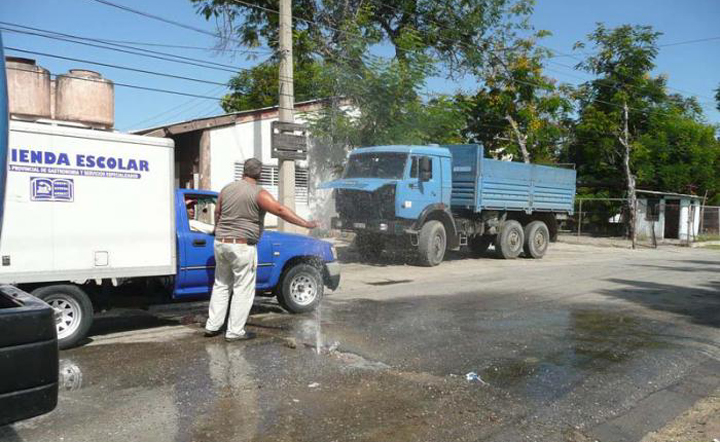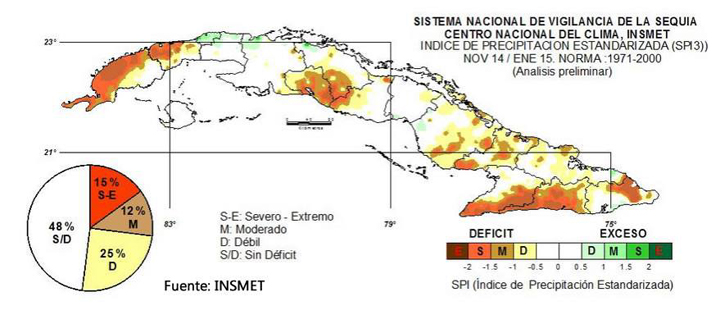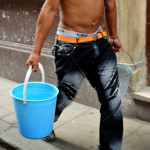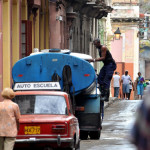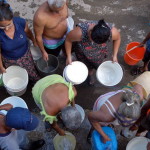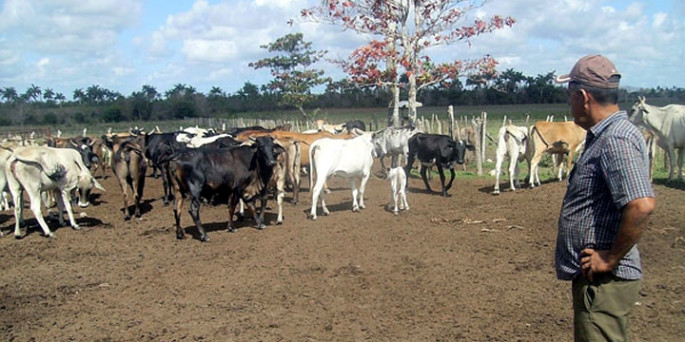
Waiting for the rain
CIEGO DE AVILA — The political and administrative authorities of this province, about 400 kilometers east of Havana, have known since late October that the accumulation of rain would not permit the province to reach the next water cycle in favorable conditions.
Nevertheless, the critical state of the aquifers in early 2015 moved the contingency plans ahead.
Of the 15 hydrogeological sectors into which the National Institute of Water Resources (INRH) divides the subterranean basis in this province, five are on alert and two on alarm status, as several months of the dry season remain.
According to Rafael González-Abreu, an INRH specialist, in 2014 Ciego de Ávila did not exceed its historical average of precipitation, barely 779 millimeters for the whole year. This is the main cause of the slow recovery of the aquifers and the reduced content of the reservoirs.
By late December, the six reservoirs in the province were at 50 percent of capacity, estimated at 150 million cubic meters of water.
However, other variables make the equation more complex. The territory has grown sustainably in the past five years, in terms of fruits and grains, and the citrus farms (devastated by the Yellow Dragon plague) have increased by about 4,000 hectares.
It is estimated that in 2014 the fruit-production project amounted to 3,000 hectares of mango, 1,600 of guava, and about 600 of pineapple, which — along with the grains (rice and beans) and the Cuban-Brazilian soybean program (CubaSoy) — demand large volumes of water for irrigation.
The exigencies of agriculture will increase further because the fruit-production program is expected to grow to 14,000 hectares by 2018.
Also, the investment process in the keys north of Ciego de Ávila (the Jardines del Rey tourist destination) raised consumption last year, when it put into operation about 600 suites and renovated 100 others. Add to this the overproduction of cane; to produce more sugar, more water was required.
The dark horse in this situation is wastage. Although figures are not available, the specialists at the INRH and the Waterways and Sewage Department say that usage of water in the government-owned and residential sectors is not efficient.
Today, more than 50 percent of the water extracted from the phreatic zone in Ciego de Ávila is lost en route because of the bad condition of the conduits. In fact, about 230 kilometers of pipe need to be replaced. Ironically, this happens in the area where one of the factories of high-density polyethylene pipes is situated.
In 2014, the output of the Ciegoplast tubing firm was directed at the rehabilitation of the water distribution networks in Havana, Camagüey, Holguín and Las Tunas.
Distress call is nationwide
News about the damage caused by the drought comes from every direction and reveals not only a climate change but also serious harm to the national economy.
In Pinar del Río, the absence of rain for long periods has forced tobacco growers to stop planting it, precisely at a time when the easing of trade announced by the Obama administration opens new opportunities for trading in this commodity. About 15,000 hectares have been planted in that western province.
According to the Institute of Meteorology (INSMET), the last quarter of 2015 was quite dry, causing a 42-percent deficit in the accumulation nationwide. The worst affected provinces were Pinar del Río and Artemisa in the west, and Las Tunas, Granma, Holguín, Santiago de Cuba and Guantánamo in the east.
In Granma, the current state of water reserves motivated a visit by the Chief of Staff of Cuba’s Civil Defense.
In that area, the rice-planting program, the nation’s largest, was affected by the scant precipitation, although no data were released.
Another high-ranking official, Ramiro Valdés, went to Santiago de Cuba last December to view the damage caused by the drought and the shortages in potable-water distribution to the population of that provincial capital.
At present, that province has less than 40 percent of the water that its 11 reservoirs can hold. That situation delays distribution to the residential areas and imposes restrictions on farming, industry and the service sector.
In late January, the central province of Sancti Spiritus had 25 depressed water sources, some of them on the edge of collapse. Forty-three thousand people received their water via trucks, according to the daily Granma.
It is known that 2014 was the warmest year in 135 years. Scientists are amazed because there was no weather oscillation caused by El Niño. Thus, 10 of the years with the highest average temperatures have passed between 1997 and 2015. This confirms the implications of climate change, the result of human action on the planet.
Keys to the contingency
According to the INSMET, Cuba’s central region will receive the least accumulation of rain during the season that ends in April.
Ninety percent of the water consumed in this central province is extracted from the phreatic zone. The subterranean sources had been estimated at 963 million cubic meters, but recent studies in the two southern sectors indicated that the accumulation declined to 295 million cubic meters, so all the basins — when full — hold only 872 million cubic meters of water.
That scenario forces the government to take steps that, while not yet extreme, will have an impact on the social and economic sectors.
The keys to the contingency include a strict control over swimming pools (private and state-run) and high-consumption organizations, in addition to self-employed entrepreneurs that operate car washes and economic activities that use a significant amount of water.
Another sector where water use is already being reduced is agriculture, where illegal plantations are often created next to a supply network.
The Ceballos Citrus Farm, a company that owns 80 percent of fruit plantations, is in the area where the wells have shown the largest decrease in their reserves.
Other farm businesses in the area could also feel the pinch of the current situation, among them La Cuba, responsible for the largest volumes of banana production in the country and in charge of an ambitious plan for grain growing.
It has been learned that the frequency and extension of irrigation will be reduced in line with the severity of the drought. Already, pumping has been suspended in 11 distribution points serving farmers’ cooperatives and land operated by the Ceballos Citrus Farm. Data on the likely economic impact are not available.
After Hurricane Flora demonstrated the inefficient (or inexistent) structures to store water, the Cuban government began a movement to build reservoirs, transfer channels and aqueducts.
This program increased storage capacity from 48 million cu. m. in 1959 to more than 9 billion cu. m. in the late 1980s.
However, the drive to improve water services diminished in the 1990s, which caused several of the projects to remain half completed or unfinished.
It wasn’t until 2004, under the threat of an extreme drought, that a decision was made to reprise the construction of transfer channels, especially in the eastern region. One decade later, the conditions to ensure “water for the entire century” have not yet been created.
The challenge in Ciego de Ávila and the rest of the country is to reach May 2015 with water reserves that guarantee sustainability.
If investments are not made quickly to prevent the growing leakages and the responsible people don’t cut back on wastage, there’s not much to do but to hope for rain and hope that the mangoes ripen.
From now on, all eyes are on the sky.
Progreso Semanal/ Weekly authorizes the total or partial reproduction of the articles by our journalists, so long as source and author are identified.

